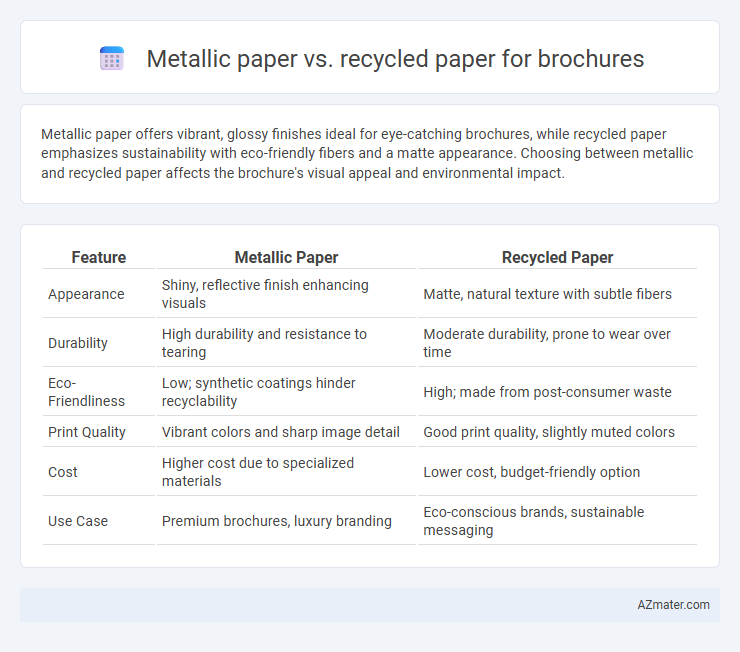Metallic paper offers vibrant, glossy finishes ideal for eye-catching brochures, while recycled paper emphasizes sustainability with eco-friendly fibers and a matte appearance. Choosing between metallic and recycled paper affects the brochure's visual appeal and environmental impact.
Table of Comparison
| Feature | Metallic Paper | Recycled Paper |
|---|---|---|
| Appearance | Shiny, reflective finish enhancing visuals | Matte, natural texture with subtle fibers |
| Durability | High durability and resistance to tearing | Moderate durability, prone to wear over time |
| Eco-Friendliness | Low; synthetic coatings hinder recyclability | High; made from post-consumer waste |
| Print Quality | Vibrant colors and sharp image detail | Good print quality, slightly muted colors |
| Cost | Higher cost due to specialized materials | Lower cost, budget-friendly option |
| Use Case | Premium brochures, luxury branding | Eco-conscious brands, sustainable messaging |
Introduction to Brochure Paper Choices
Metallic paper offers a glossy, reflective finish that enhances color vibrancy and visual appeal, making it ideal for high-impact brochures requiring premium presentation. Recycled paper provides an eco-friendly alternative with a natural texture that appeals to environmentally conscious audiences while maintaining print quality. Choosing between metallic and recycled paper depends on the desired aesthetic, brand values, and target audience preferences for brochure materials.
What is Metallic Paper?
Metallic paper features a unique glossy finish with a shimmering effect created by embedded aluminum particles, making it ideal for high-impact brochure designs that demand a luxurious and eye-catching appearance. This paper type enhances color vibrancy and contrast, providing a premium look often used in marketing materials for luxury brands and special events. Unlike recycled paper, which prioritizes sustainability, metallic paper focuses on visual appeal and texture, resulting in a heavier weight and less eco-friendly profile.
What is Recycled Paper?
Recycled paper is produced from reclaimed paper fibers, reducing the need for virgin wood pulp and minimizing environmental impact through decreased deforestation and waste. It often contains a blend of post-consumer and post-industrial fibers, ensuring quality while promoting sustainability. Compared to metallic paper, recycled paper offers a more eco-friendly option for brochures, emphasizing biodegradability and reduced carbon footprint.
Visual Impact: Metallic vs. Recycled Paper
Metallic paper delivers a high-gloss, reflective finish that enhances colors and graphics, making brochures visually striking and eye-catching, ideal for premium branding. Recycled paper offers a matte, textured surface that conveys eco-friendliness and authenticity but provides a subdued visual impact compared to metallic finishes. Choosing between metallic and recycled paper depends on the desired brand message: vibrant sophistication versus sustainable simplicity.
Print Quality and Color Vibrancy
Metallic paper enhances brochure print quality with its reflective surface, delivering sharp text and vivid images that stand out in marketing materials. Recycled paper offers a matte finish, often resulting in softer color vibrancy and slightly muted tones due to its fiber content. Choosing metallic paper maximizes color brilliance and detail, while recycled paper prioritizes eco-friendliness with a more subdued but natural print appearance.
Durability and Texture Differences
Metallic paper offers superior durability with a glossy, reflective surface that resists wear and tear, making it ideal for high-impact brochures requiring a premium look. Recycled paper, while more eco-friendly, typically has a rougher texture and lower resistance to bending and moisture, which may affect longevity in frequent handling. The choice between metallic and recycled paper depends on whether durability and sleek texture or sustainability and eco-consciousness are the primary priorities.
Environmental Considerations
Metallic paper for brochures features a glossy, reflective finish but often relies on non-recyclable coatings and contains synthetic fibers, raising concerns about environmental impact and landfill waste. Recycled paper, made from post-consumer materials, reduces deforestation and energy consumption, offering a more sustainable choice with lower carbon emissions throughout production. Choosing recycled paper supports circular economy principles and facilitates easier end-of-life recycling, minimizing ecological footprint compared to metallic paper options.
Cost Comparison: Metallic vs. Recycled
Metallic paper generally costs 30-50% more than recycled paper due to its complex manufacturing process and premium finish. Recycled paper is more budget-friendly, offering eco-conscious brands a cost-effective option without sacrificing quality. Businesses aiming to balance cost and sustainability often prefer recycled paper for brochures to minimize expenses.
Branding Implications and Audience Perception
Metallic paper enhances brochure branding by conveying luxury, sophistication, and high quality, making it ideal for premium products or services targeting affluent audiences. Recycled paper, on the other hand, signals environmental responsibility and sustainability, appealing to eco-conscious consumers and reinforcing a brand's commitment to green values. Choosing between metallic and recycled paper shapes audience perception by aligning the brochure's tactile experience with the brand's core message and market positioning.
Choosing the Best Paper for Your Brochure
Metallic paper offers a glossy, eye-catching finish that enhances vibrant colors and adds a premium feel to brochures, making it ideal for luxury brands and high-impact marketing materials. Recycled paper prioritizes environmental sustainability by using post-consumer waste, appealing to eco-conscious consumers and companies aiming to reduce their carbon footprint. Selecting the best paper depends on balancing visual impact with ecological responsibility, ensuring your brochure aligns with both your brand identity and target audience values.

Infographic: Metallic paper vs Recycled paper for Brochure
 azmater.com
azmater.com